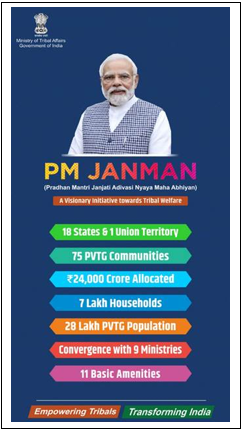Syllabus:
GS-2: Welfare schemes for vulnerable sections of the population by the Centre and States and the performance of these schemes; mechanisms, laws, institutions and Bodies constituted for the protection and betterment of these vulnerable sections.
Context: The Ministry of Tribal Affairs has written to the Registrar General and Census Commissioner of India, urging a separate Census enumeration for Particularly Vulnerable Tribal Groups (PVTGs).
Need for the Separate Census
• Marginalisation: PVTGs are among the most vulnerable and socio-economically deprived communities within Scheduled Tribes.
• Tailored Welfare: Accurate data is essential for designing and implementing focused schemes like PM-JANMAN.
• Underrepresented Data: The 2011 Census collected data for Scheduled Tribes as a whole but did not enumerate PVTGs separately.
• Unique Needs: Capturing household-level information on PVTGs’ demographic and socio-economic traits is vital for evidence-based policymaking.
• Classification: In 2011 census, around 40 PVTGs were listed as single entries under the broader ST category, masking their distinct vulnerabilities.
• Policy Planning: Separate enumeration would ensure better monitoring, fund allocation, and impact assessment of tribal welfare initiatives.
Pradhan Mantri Janjati Adivasi Nyaya Maha Abhiyan (PM JANMAN)

• Launched in 2023, PM-JANMAN seeks to improve the living conditions of the 75 PVTGs by providing comprehensive and inclusive support.
• The basic objective of the PM-JANMAN is to improve socio-economic conditions of the PVTGs, by saturating PVTG families and habitations with basic facilities and services.
• The scheme aims to improve the socio-economic status of PVTGs by bridging gaps in health, education, livelihoods; by improving basic infrastructure in PVTG communities, habitations, and families aligning with existing schemes
• Nine Union Ministries will converge through 11 critical interventions for the welfare of the PVTGs, with the Ministry of Tribal Affairs as the nodal ministry.
• The programme focuses on providing basic facilities such as housing, safe drinking water, education, healthcare and nutrition, along with better road and telecom connectivity, electricity for households that are still unelectrified and livelihood opportunities.
• The target is to cover these needs within three years, i.e., 2023-24 to 2025-26.
• The total budgetary outlay for the scheme is Rs 24,104 crore, with the central share amounting to Rs 15,336 crore and the state share being Rs 8,768 crore.
Particularly Vulnerable Tribal Groups (PVTGs)
• There are 75 PVTGs in India across 18 states and one Union Territory of Andaman and Nicobar Islands.
• Odisha has the highest number of PVTG communities (13) and the largest PVTG population, estimated at over 2.5 lakh.
• Based on the Dhebar Commission’s recommendations, the Government of India created a separate category called Primitive Tribal Groups (PTGs) in 1973, which were renamed Particularly Vulnerable Tribal Groups (PVTGs) in 2006.
• PVTGs have some basic characteristics: they are mostly homogenous, with a small population, relatively physically isolated, social institutions cast in a simple mould, absence of written language, relatively simple technology and a slower rate of change etc.
• The Government of India follows the following criteria for identification of PVTGs:
- Pre-agricultural level of technology
- Low level of literacy
- Economic backwardness
- A declining or stagnant population.
• According to Ministry of Tribal Affairs the estimated PVTG population is 45.56 lakh. Madhya Pradesh (12.28 lakh), Maharashtra (6.2 lakh) and Andhra Pradesh (4.9 lakh) are the top three in terms of PVTG population.

